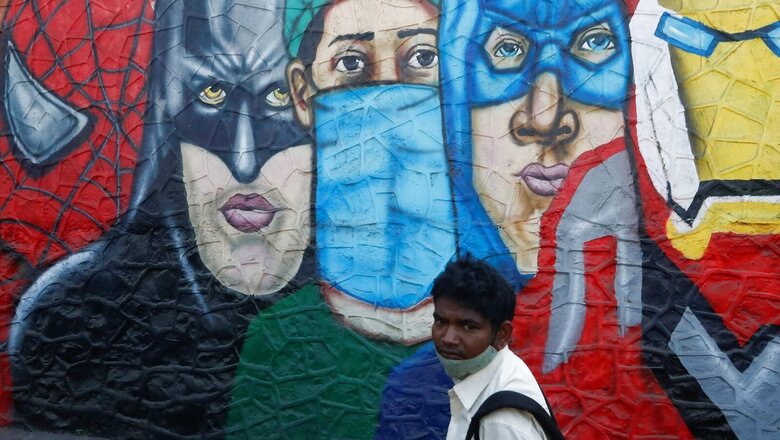
views
At least 18 cases of XBB sub-variant of Omicron have been reported in Maharashtra in the first fortnight of October, the state health department said on Wednesday. A health official said 13 of these cases are from Pune, two each from Nagpur and Thane and one from Akola district. As per INSACOG labs’ latest report, 18 cases of XBB variant have been reported in the state in the first fortnight of October month, he said. Apart from these cases, Pune has also reported one case each of BQ.1 and BA.2.3.20 sub-variants. These cases are from the period of September 24 to October 11.
As per the primary information, all these cases are mild. It said 15 out of these 20 cases (18 of XBB and one each of BQ.1 and BA.2.3.20) were vaccinated against COVID-19 while information on the rest five cases is to be received. The BQ.1 case in Pune is of mild variety and has a history of travel to the USA. “Genetic mutations are part of the natural life cycle of the virus and there is no need to be concerned about this but to take appropriate precautions for COVID containment,” it said.
Meanwhile, the state health department on Monday cited the XBB variant as well as winters and the festive season, as factors that could fuel further spikes.
The BA.2.3.20 and BQ.1 variants were also discovered in the state, a first for the country.
And in view of new genetic variants of Covid-19 being reported from different parts of the world, Kerala government on Monday said it is intensifying preventive measures in the state. Kerala Health Minister Veena George in a statement said as the new genetic variants — XBB and XBB1 — of Covid-19 are more contagious than earlier ones, everyone — especially the elderly and those suffering from co-morbidities — should be more careful and wear masks properly for self protection.
Since the elderly and those with co-morbidities are more likely to be severely affected by the new Covid variants, they as well as healthcare workers must take the booster/ precautionary dose of the vaccine. She requested that masks be worn at airports and in closed public places. The minister further said around 1.8 per cent of those infected by the new variants may require hospitalisation, but as of now there was no cause for concern.
A report by Hindustan Times stated that at least 10-15% of samples sequenced in India show the presence of XBB, according to people familiar with the matter. It further said that while there are no signs of the highly immune evasive BA.5 sub-lineages—BQ.1 and BQ.1.1—that are currently driving cases in the US and Europe, it was only ‘a matter of time before they appear in India’.
What are these Variants We Need to Watch Out for?
BQ.1 and BQ.1.1 are sub-lineages of BA.5, which displaced the dominant Spring season BA.2. These appear to be even more fit than BA.5, with higher transmissibility, particularly in the United States and Europe, the report by HT said. India has no significant presence of these variants.
BA.2.75.2 is more similar to BA.2. In terms of threat, this version may be comparable to BA.5 successors. A recent study by Chinese researchers discovered that this variant, too, has high antibody resistance. It is currently the most common variant in India.
BJ.1 is a BA.5 sublineage with a large number of spike protein mutations (13). The majority of global sequences originate in India, and it may be widespread in certain states.
XBB, a hybrid of Omicron’s BA.2.75 and BJ.1 subvariants, was discovered in Singapore in August and has been linked to a significant increase in Covid-19 cases on the island. Experts have said the variant is highly immunity-evasive, and may even pose a challenge to the new Omicron bivalent vaccines.
The Hindustan Times report quotes an INSACOG member as saying that all the variants are “all cousins of Omicron” and that “only names change with time because WHO reclassifies the mutants on a regular basis depending on the trend.”
The person further said that the body will be analysing data retrospectively, and that there existed a “high probability” that the other sub-variants that are driving the surge in Western countries were already present in India.
The INSACOG member said subvariant naming was based on set algorithms and that when a new name is added, the previous strains are reclassified. As a result, they said, “we may already have some of these new mutants in our system.”
XBB a Concern?
Scientists from various Chinese institutes have called XBB the most antibody evasive strain tested, reports said. They added that XBB appears to be on its way to surpassing BA.2.75.2’s immune evasive status.
“BA.2.75.2 was recently shown to be the most immune evasive variant seen to date and replicated. That has now been surpassed by XBB, which is predicted to challenge BA.5 bivalent vaccine protection,” Eric Topol, a physician scientist who has been extensively analysing Sars-Cov-2 data, said in a tweet.
According to the INSACOG member, BA.2.75 remains the dominant variant in India. The data from genome sequencing laboratories is analysed using field data trends to investigate the relationships between genomic variants and epidemiological trends.
They further said that while the percentage of XBB may be increasing, there was no reason to be concerned in terms of increased hospitalizations or deaths, adding that the situation is the same in Singapore, where there has been an XBB spike; no increased hospitalisation or death rate. “Aside from that, we must remain vigilant, and we are closely monitoring trends,” they said.
Dr. GC Khilnani, former department head of pulmonology at the All India Institute of Medical Sciences in Delhi told the Hindustan Times that being an RNA virus, “it will mutate at a faster rate”.
According to the expert, what remained to be seen was whether the mutations were virulent enough to cause severe disease that necessitates hospitalisation, or if they are causing more deaths. He said that in terms of the clinical impact, “we are not seeing an increase in hospitalizations”.
“The majority of patients are testing and recovering at home. So far, there is no cause for concern,” he said.
Read all the Latest Explainers News and Breaking News here




















Comments
0 comment